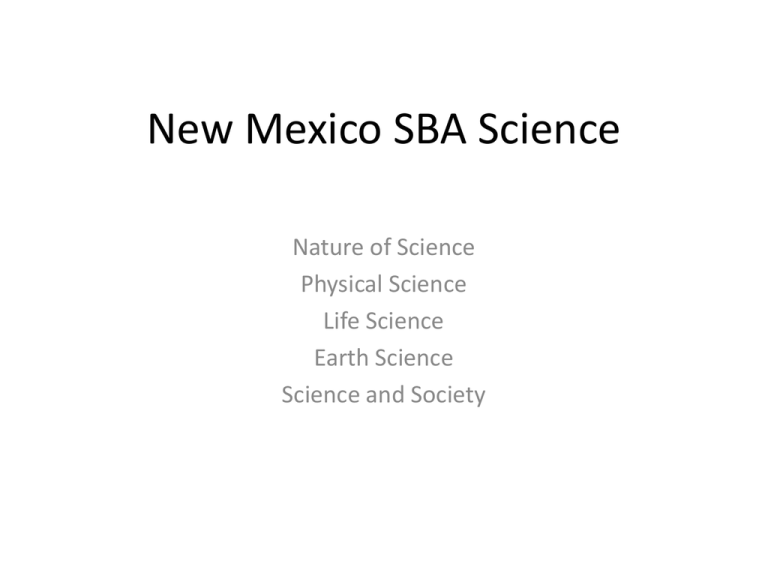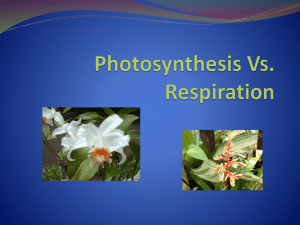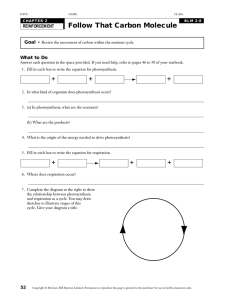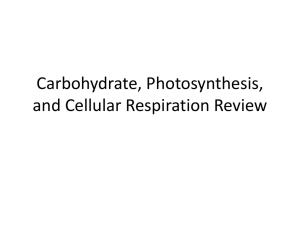New Mexico SBA Science Nature of Science Physical Science Life Science
advertisement

New Mexico SBA Science Nature of Science Physical Science Life Science Earth Science Science and Society Atoms • Atoms are the fundamental building block of ordinary matter. • They are smallest identifiable unit of an element. • They are so small you can’t even see them with a microscope. Ionic bonds • Bonds are formed by the transfer of electrons. The charges hold the atoms together. Covalent bonds Elements share valence electrons to form the bond Transforming Energy • Law of conservation of Energy: energy is neither created nor destroyed only transformed. • Some energy transformation is not useful for us. – Example: Power lines transform energy into heat. Published January 27, 2011 | By Amanda Kaufmann Fossil Fuels • Formed by decay of ancient plants and animals • When burned they produce carbon dioxide and water • Petroleum, • Natural Gas, and coal Natural Gas • Composed mainly of Methane. • Natural gas contains more energy per kilogram than either petroleum or coal. • Produces fewer pollutants than other fossil fuels Coal • Solid fossil fuel found underground • One fourth of our energy comes from coal. • Coal is formed from organic material deposited in ancient swamps. • Burning coal results in more pollutants Generating Electricity • Conduction: is a heat transfer when 2 objects are touching (direct contact) • There is NO transfer of matter • Conduction works fastest with: – Solids Liquids Gases • The particles of liquids and gases are farther apart than solids, therefore heat is not transferred as quickly • Convection: heat transfer that takes place in fluids (liquids and gases) • HOT AIR/WATER RISES • Convection Currents: currents in liquids or gases, these currents transfer thermal energy (caused by difference in density) • Ex. Pavement, beaker of hot water, ocean currents, weather patterns, wind • Radiation: is the transfer of thermal energy (heat) by waves through space • Radiation happens through air and empty space • Ex. Sun, wood burning stove, fireplace, candles • All objects radiate thermal energy Earth’s Atmosphere • The air is a mixture of gases, Nitrogen, Oxygen and trace gases. • Microorganisms produce the gases. • The theory is that over time the atmosphere developed into the air we now breath. Moon Phases Heating (energy in) the Atmosphere Wind • Winds are caused by differences in air pressure • Local Winds: are caused by unequal heating of the earth’s surface in a small area. http://www.vivoscuola.it/us/rsigpp3202/umidita/lezioni/form.htm Cloud formation Climates • Two things determine a regions climate: • Temperature and Precipitation Temperature • • • • Latitude Distance from large bodies of water Ocean currents altitude Topographic Map • A two-dimensional representation of a portion of the threedimensional surface of the earth • The following are general characteristics of contour lines:1. Contour lines do not cross each other, divide or split. 2. Closely spaced contour lines represent steep slopes, conversely, contour lines that are spaced far apart represent gentle slopes. 3. Contour lines trend up valleys and form a "V" or a "U" where they cross a stream. • • • • Precipitation Latitude Distribution of air pressure systems Global winds Mountain barriers http://mycozynook. com/102RGCh34OH. htm Conservation of energy – energy is neither created nor destroyed; it just transfers into different forms. Let us look at two forms of energy: potential energy – stored energy kinetic energy – energy of motion When the cart is at the top, it has lots of stored energy because of gravity. Let us look at two forms of energy: potential energy – stored energy kinetic energy – energy of motion This moving cart is representing kinetic energy. Chemical reactions are an example of potential energy. The energy is stored in the bonds between the molecules. Once the chemical reacts with another chemical, it gives off energy. Food has stored energy for our muscles. This allows our muscles to move and get stuff done. C). Photosynthesis occurs in the chloroplasts of plants. 1). Chloroplasts have two important structures: a). Thylakoids: Photosynthetic sacs that make up the membrane that surrounds the chloroplast. b). Stroma: The fluid portion of the chloroplast outside of the thylakoids. Photosynthesis & Respiration I). Photosynthesis and Respiration A). Photosynthesis 1). Is a chemical reaction that uses energy from the sun, carbon dioxide from the atmosphere and water to create sugars for energy for themselves and animals that eat the sugars and oxygen. 2). Chemical Reaction for Photosynthesis: 6CO2 + 6H2O Light C6H12O6 + 6O2 Carbon Dioxide Oxygen water Sugars B). Respiration 1). Is a chemical reaction that uses sugars created by plants during photosynthesis, and oxygen to release energy, water and carbon dioxide. 2). Chemical Reaction for Respiration: 6O2 + C6H12O6 6CO2 + 6H2O + Energy Oxygen Glucose (Sugar) Carbon Dioxide Water II). The Relationship between Photosynthesis and Respiration. A). Photosynthesis and respiration are basically the opposite of each other. B). Photosynthesis removes carbon dioxide from the atmosphere, and cellular respiration puts it back. Photosynthesis releases oxygen into the atmosphere and cellular respiration uses that oxygen to release energy from food. Producers, consumers, decomposers Natural Selection, how species change and new species arise. • Organisms create too many offspring because… • There are limited resources (food, water, space), this causes competition… • In a species there are variations, they are not identical… • The organisms that have the “best” traits survive • They reproduce, have babies.. – These babies are like their parents. Differences from year to year can build up so that eventually an organism is different from it’s ancestors. A new species Evidence of evolution • Fossils, genetic similarities, physical similarities like the bones in arm of mammals. Peppered Moth • Peppered moths have colors from light to dark. Variations. • The trees were light so dark moths were easier to see by the predators. • The industrial revolution stained the trees dark, soot from burning coal. Light moths were easier to see by the predators. • The population became dark with few light moths. • Today the trees are returning to their light appearance and the population is changing. Roundup resistant weeds, natural selection Roundup is a herbicide, plant killer. When it first was used it killed all plants. The company made corn resistant to roundup. Spray a field, no weeds only corn. Today there are plants that roundup does not kill, these are new kinds of plants. Variation in weeds. Spray chemicals that kill weeds. Selection Survival of resistant types, new plant Artificial Selection, dairy cows • Cattle were domesticated by man long ago. • Some cows made more milk than other cows. Variation • Man kept the “good” milk cow and used it to make more “good” milk cows. Selection • Different types of cattle created by artificial selection Scientific Method • You will need to design an experiment. “Why is that plant bigger than the others?” The Problem 1. Create a possible solution. Hypothesis That plant gets more water. If I gave the other plants more water they would grow bigger. A Prediction 2. Design a test. The Experiment. Get several plants, (must be the same kind of plant.) Provide the same soil and water and temperature to every plant. Every plant is treated the same. The Controls Provide some plants with more light than the other plants and measure the growth.The Variable. 3. Measure the size of the plants. The Data 4. Determine if the amount of light made a difference in plant growth. The Analysis • An organism’sgenotype is the set of genes that it carries. An organism’s phenotype is all of its observable characteristics—which are influenced both by its genotype and by the environment. So in defining evolution, we are really concerned with changes in the genotypes that make up a population from generation to generation. However, since an organism’s genotype generally affects its phenotype, the phenotypes that make up the population are also likely to change.






